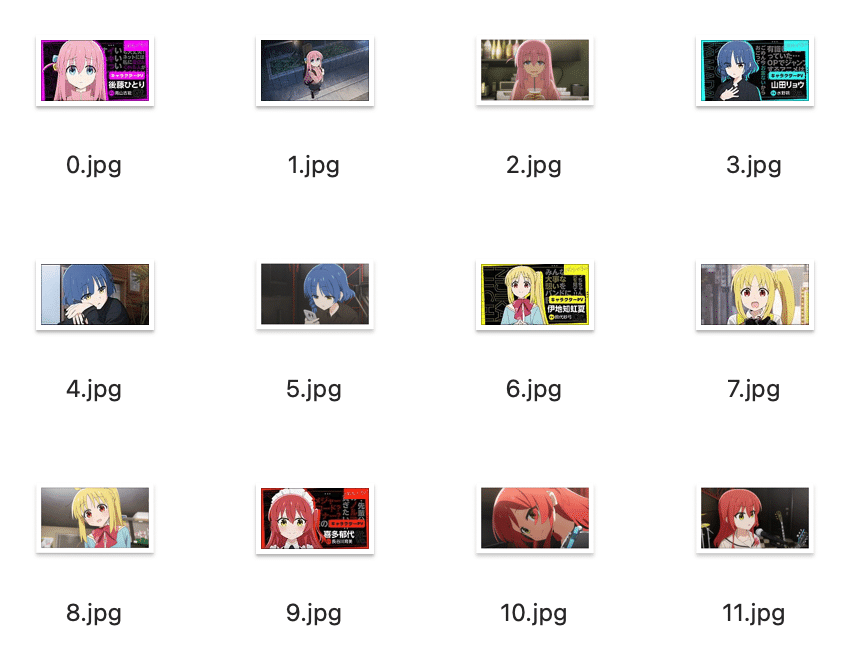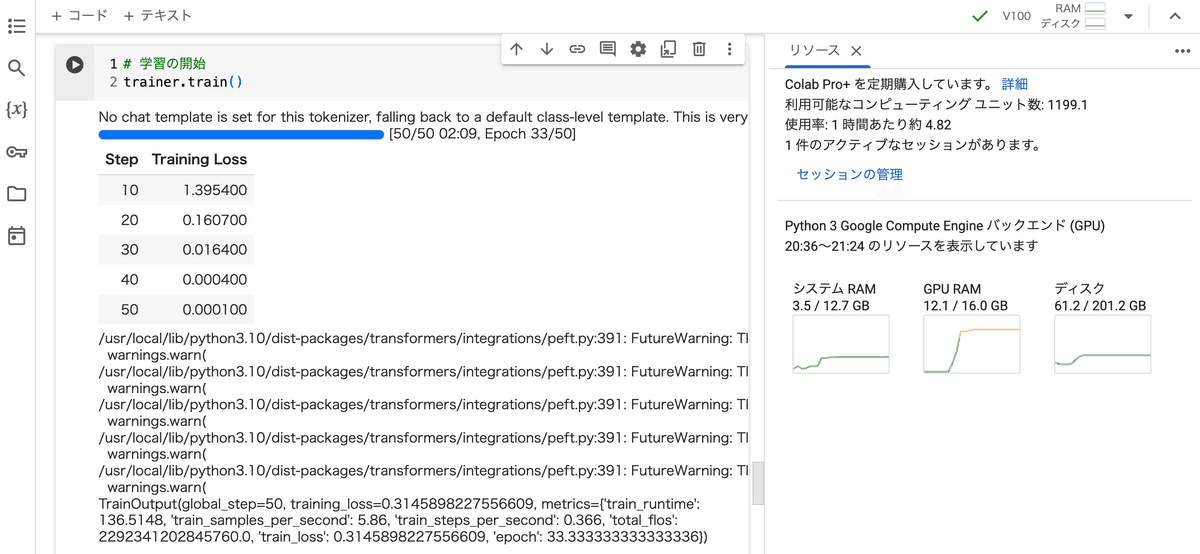
オリジナルデータセットで Idefics2 のファインチューニングを試す
オリジナルデータセットで高性能なオープンVLM「Idefics2」のファインチューニングを試したので、まとめました。
【注意】Google Colab Pro/Pro+のV100で動作確認しています。
前回
1. Idefics2
「Idefics2」は、テキストと画像を入力し、テキストを出力するマルチモーダルモデルです。画像の質問応答、視覚的コンテンツの説明、複数画像をもとに物語作成、文書からの情報抽出などを実行できます。
前回は提供されているデータセットで学習しましたが、今回はオリジナルデータセットを作って学習させてみます。
2. データセットの作成
画像に写っているキャラクターの名前を学習するためのデータセットを作成します。
2-1. データの準備
今回は、結束バンドのメンバー4名の画像を学習用に3枚ずつ、評価用に1枚ずつあつめて、名前といっしょに学習させます。
画像サイズは 980x980px以下 にします。
・学習用データ

・評価用データ

2-2. データセットの作成
データセットの作成手順は、次のとおりです。
(1) Colabのノートブックを開き、メニュー「編集 → ノートブックの設定」で「GPU」の「V100」を選択。
(2) パッケージのインストール。
# パッケージのインストール
!pip install -q git+https://github.com/huggingface/transformers.git
!pip install -q accelerate datasets peft bitsandbytes(3) 学習データをColabにアップロード。
左端のフォルダアイコンでファイル一覧を表示し、trainフォルダとevalフォルダを作成し、学習データと評価データをアップロードします。

(4) 学習データセットの作成。
imageにPIL画像、queryに質問、answerに応答を記述します。
from PIL import Image
from datasets import Dataset
# キャラクター名
names = [
"後藤ひとり",
"山田リョウ",
"伊地知虹夏",
"喜多郁代",
]
# 学習データの準備
image = []
query = []
answer = []
for i in range(12):
image.append(Image.open("train/" + str(i) + ".jpg"))
query.append("このキャラクターの名前は?")
answer.append("このキャラクターの名前は" + names[int(i/3)] + "です。")
# 学習データセットの作成
train_dataset = Dataset.from_dict({
"image": image,
"query": query,
"answer": answer
})
print(train_dataset)Dataset({
features: ['image', 'query', 'answer'],
num_rows: 12
})(5) 評価データセットの作成。
# 評価データの作成
image = []
query = []
answer = []
for i in range(4):
image.append(Image.open("eval/" + str(i) + ".jpg"))
query.append("このキャラクターの名前は?")
answer.append("このキャラクターの名前は" + names[i] + "です。")
# 評価データセットの作成
eval_dataset = Dataset.from_dict({
"image": image,
"query": query,
"answer": answer
})
print(eval_dataset)Dataset({
features: ['image', 'query', 'answer'],
num_rows: 4
})3. 学習
Colabでの学習手順は、次のとおりです。
(1) プロセッサーとモデルの準備。
import torch
from peft import LoraConfig
from transformers import AutoProcessor, BitsAndBytesConfig, Idefics2ForConditionalGeneration
# パラメータ
DEVICE = "cuda:0"
USE_LORA = False
USE_QLORA = True
# プロセッサーの準備
processor = AutoProcessor.from_pretrained(
"HuggingFaceM4/idefics2-8b",
do_image_splitting=False
)
# モデルの準備
if USE_QLORA or USE_LORA:
lora_config = LoraConfig(
r=8,
lora_alpha=8,
lora_dropout=0.1,
target_modules='.*(text_model|modality_projection|perceiver_resampler).*(down_proj|gate_proj|up_proj|k_proj|q_proj|v_proj|o_proj).*$',
use_dora=False if USE_QLORA else True,
init_lora_weights="gaussian"
)
if USE_QLORA:
bnb_config = BitsAndBytesConfig(
load_in_4bit=True,
bnb_4bit_quant_type="nf4",
bnb_4bit_compute_dtype=torch.float16
)
model = Idefics2ForConditionalGeneration.from_pretrained(
"HuggingFaceM4/idefics2-8b",
torch_dtype=torch.float16,
quantization_config=bnb_config if USE_QLORA else None,
)
model.add_adapter(lora_config)
model.enable_adapters()
else:
model = Idefics2ForConditionalGeneration.from_pretrained(
"HuggingFaceM4/idefics2-8b",
torch_dtype=torch.float16,
_attn_implementation="flash_attention_2", # Only available on A100 or H100
).to(DEVICE)
(2) DataCollatorの準備。
import random
# DataCollatorの準備
class MyDataCollator:
def __init__(self, processor):
self.processor = processor
self.image_token_id = processor.tokenizer.additional_special_tokens_ids[
processor.tokenizer.additional_special_tokens.index("<image>")
]
def __call__(self, examples):
texts = []
images = []
for example in examples:
# データ抽出
image = example["image"] # 画像
question = example["query"] # 質問
answer = example["answer"] # 応答
# メッセージリストの作成
messages = [
{
"role": "user",
"content": [
{"type": "text", "text": "Answer briefly."},
{"type": "image"},
{"type": "text", "text": question} # 質問
]
},
{
"role": "assistant",
"content": [
{"type": "text", "text": answer} # 応答
]
}
]
# テキストの画像の追加
text = processor.apply_chat_template(messages, add_generation_prompt=False)
texts.append(text.strip())
images.append([image])
batch = processor(text=texts, images=images, return_tensors="pt", padding=True)
labels = batch["input_ids"].clone()
labels[labels == processor.tokenizer.pad_token_id] = self.image_token_id
batch["labels"] = labels
return batch
data_collator = MyDataCollator(processor)(3) 学習パラメータとトレーナーの準備。
from transformers import TrainingArguments, Trainer
# 学習パラメータの準備
training_args = TrainingArguments(
num_train_epochs=2,
per_device_train_batch_size=2,
per_device_eval_batch_size=8,
gradient_accumulation_steps=8,
warmup_steps=50,
learning_rate=1e-4,
weight_decay=0.01,
logging_steps=10,
max_steps=50,
output_dir="./idefics2-bocchi-8b",
save_strategy="steps",
save_steps=10,
save_total_limit=1,
fp16=True,
remove_unused_columns=False,
report_to="none",
)
# トレーナーの準備
trainer = Trainer(
model=model,
args=training_args,
data_collator=data_collator,
train_dataset=train_dataset,
)(4) 学習の開始。
V100で2分ほどかかりました。
# 学習の開始
trainer.train()
4. 評価
Colabでの学習手順は、次のとおりです。
(1) 評価データの準備。
# 評価データの準備
example = eval_dataset[0]
example{'image': <PIL.Image.Image image mode=RGB size=640x360>,
'query': 'このキャラクターの名前は?',
'answer': 'このキャラクターの名前は後藤ひとりです。'}(2) 評価画像の確認。
# 評価画像の確認
example["image"](3) 推論の実行。
model.eval()
image = example["image"]
query = example["query"]
# メッセージリストの準備
messages = [
{
"role": "user",
"content": [
{"type": "text", "text": "Answer briefly."},
{"type": "image"},
{"type": "text", "text": query}
]
}
]
# 推論の実行
text = processor.apply_chat_template(messages, add_generation_prompt=True)
inputs = processor(text=[text.strip()], images=[image], return_tensors="pt", padding=True)
generated_ids = model.generate(**inputs, max_new_tokens=64)
generated_texts = processor.batch_decode(generated_ids[:, inputs["input_ids"].size(1):], skip_special_tokens=True)
print(query)
print(generated_texts)このキャラクターの名前は?
['このキャラクターの名前は後藤ひとりです。']
この記事が気に入ったらサポートをしてみませんか?
